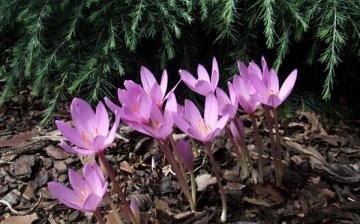Colchicum autumn - a poisonous handsome man
Many summer residents would like to plant plants on their plots in such a way that, even in autumn, complete desolation and the absence of bright colors pleasing to the eye are not observed in the garden.
One of the plants blooming in the fall, which can be advised for planting on the site, is the autumn crocus or colchicum.
There is a misconception that the crocus belongs to the genus of autumn-flowering crocuses. However, these plants belong to completely different plant families. And it is also worth noting that, unlike crocuses, all parts of the crocus are extremely poisonous and require care and the use of gloves when planting and caring for them.
It is recommended to plant crocus in the form of groups, these flowers look especially advantageous in an almost colorless garden under trees and shrubs, planted near reservoirs.
The perianths of colchicum are devoid of leaves, therefore delicate pink goblet flowers with six yellow stamens look bright and expressive against the background of a calm autumn landscape.
It is curious that in the summer the autumn crocus does not show any signs of life. This bulbous plant is in a state of sleep during the summer months, gaining strength and nutrients for autumn flowering.
With the onset of autumn, the bulb gives roots, and a leafless sprout appears on the surface - the perianth, directly on which the most delicate pink flower is located. After flowering, the aerial part of the plant dies off, and the colchicum again becomes invisible to the eye until spring.
In spring, the plant forms a leafy stem with a seed capsule at the end, which is recommended to be removed in order to exclude self-sowing of plants.



